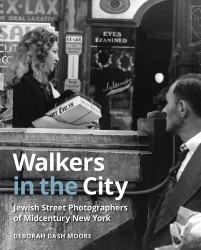For New Yorkers of a certain age, Kibbitz & Nosh will kindle warm memories. Leafing through Marcia Bricker Halperin’s photographs immediately recalls picking up your tray, proceeding to the line, and, often with much difficulty, selecting your meal from a dizzying array of choices.
The cafeteria was a landmark of Brooklyn, the Bronx, and Manhattan Jewish neighborhoods, serving working-class customers familiar food at breakfast, lunch, and dinner late into the night. Dubrow’s was a well-known chain of cafeterias, opulent in design yet reasonably priced. In its heyday, it was a hangout for small-time racketeers and gangsters as well as politicians and businessmen, teachers, and neighborhood drop-ins. In his essay, playwright David Margulies fondly recalls Sunday lunches at Dubrow’s before a matinee movie — a double feature — or a shopping trip for school clothes in the 1950s.
In another essay, historian Deborah Dash Moore offers an informative overview of the impact of the cafeteria — specifically Dubrow’s — on Jewish life in Brooklyn, the Bronx, and midtown Manhattan. By 1920, the Jewish population in New York City had grown to 1.6 million, and establishments of all kinds, among them cafeterias, catered to Ashkenazi Jewish tastes. With its self-service style, there were no waiters, and customers could linger for hours with their newspapers, a Danish, and a cup of coffee. Because of their neighborhood character, cafeterias attracted regulars, evoking Ray Oldenburg’s third place: neither work nor home, it was a public space to relax and socialize.
Marcia Bricker Halperin began photographing Dubrow’s in the mid-1970s and continued through the last days of the cafeteria in the mid-1980s. Her camera catches men with fedoras and cigars, retirees poring over newspapers and endless cups of coffee, and women with carefully coiffed hair, refreshing themselves after a day of shopping. There are no children in these photographs, and only a few young faces. Photographing the steady stream of older customers, Halperin sensed she was documenting an extraordinary, albeit vanishing, world.
The contact sheets of these photographs sat in her files until she retired and recovered them. Each image brings the cafeteria back to life, if only briefly. Just looking at a photograph of Dubrow’s famous Kaiser rolls sets off the aroma of freshly baked bread. Handsomely designed and printed, Kibbitz & Nosh draws readers into this rich, forgotten world, exploring a notable period and institution in Jewish life in America.
Maron L. Waxman, retired editorial director, special projects, at the American Museum of Natural History, was also an editorial director at HarperCollins and Book-of-the-Month Club.




